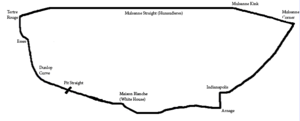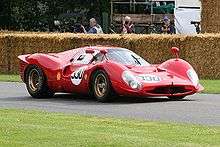1966 24 Hours of Le Mans
| 1966 24 Hours of Le Mans | |
| Previous: 1965 | Next: 1967 |
| Index: Races | Winners | |
The 1966 24 Hours of Le Mans was the 34th Grand Prix of Endurance, and took place on 18 and 19 June 1966.[1] It was also the seventh round of the 1966 World Sportscar Championship season. This was the first win at LeMans for the Ford GT40 and the first win for an American car company. It was the first time that Henri Pescarolo entered the race, a driver who went on to set the record for the most starts.

Pre-race
In 1966, the Ford GT40 Mk. II had become reliable (after Ford had failed to win in 1964 and 1965).[2][3] Shelby test driver Ken Miles managed to win at the 24 Hours of Daytona[4] and the 12 Hours of Sebring[5] with the big block Ford. Ford sent no less than eight Mk. IIs to La Sarthe, entered by three teams: Shelby, Holman & Moody and Alan Mann Racing. Ferrari sent only two works Ferrari 330 P3s to compete against the Ford armada. Another P3 was entered by NART, and four 365 P2 were entered by Ferrari's usual private partners.[6]
Race


The two works P3s were involved in an accident. At 01:45 the P2s had already exhausted their engine in trying to keep contact with the Mk. II and the last Ferrari prototype, the Pedro Rodríguez/Richie Ginther NART P3 retired with overheating. The race was won for Ford. For the first time in history an American car had won Le Mans.[7][8]
At the last pit stop, three Mark IIs were in front. Ken Miles and Denny Hulme were leading, followed by Bruce McLaren and Chris Amon in the same lap. Ronnie Bucknum and Dick Hutcherson were third, but twelve laps behind.
At the end of the race, Ford decided to stage a publicity photo.[9] The plan was to have the top three podium finishers (car numbers 1, 2, and 5, in that order) cross the line near one another to provide a photographic finish, depicting Ford's dominating race performance. Miles's #1 car was leading until the drivers were told to close up for the finish. As it turned out McLaren's #2 car crossed the finish line in first place and was declared the winner. It is rumored that Miles, upset about the team orders, allowed McLaren to finish ahead. Car #5 finished close behind the other two Fords.

Controversy surrounds the finish of this race,[10][11] suggesting that Ford #2 was given the win due to a detail of the Le Mans rules - namely that the #2 car qualified fourth (therefore starting further down the grid) and had therefore driven farther than the #1 car, even though they crossed the finish line nearly side-by-side. Film of the final lap of the race and photos of the finish show that Ford #2 car actually crossed the finish line first. The official Ford press release, dated 7 May 1966, claims:
"The McLaren-Amon and the Miles-Hulme cars were running within seconds of each other as the race neared its end, with the Bucknum-Hutcherson car hanging back as insurance. A decision was made in the Ford pits to have the cars finish side by side in what hopefully would be considered a dead heat. All three cars went over the finish in formation, but any chance for a dead heat disappeared when officials discovered a rule that in case of a tie, the car that had started further down the grid had traveled the farther distance. Since McLaren and Amon had started 60 feet behind Miles and Hulme, they were declared the winners. Both New Zealanders who now reside in England, it was the most important victory yet for the two youngsters. McLaren, who builds his own Formula and sports cars, is 28. Amon 22, is the youngest winner in the history of the event. It was a record shattering performance as the winning car covered more miles (3,009.3) at a faster speed (125.38 mph) than any previous entry. It demonstrated that production engines could compete with racing powerplants and that an American-built car could top Europe's best."
The Ford team's decision was a big disappointment for Ken Miles, who expected the 'Endurance Racing Triple Crown'—Daytona-Sebring-Le Mans—as a reward for his investment in the GT40 development. "I'm disappointed, of course, but what are you going to do about it."[12] Two months later, Ken Miles died while testing the next generation Ford GT40 J-Car, which became the MkIV that won Le Mans in 1967.[13]
"Go Like Hell"
The race became the subject of a 2009 book, detailing the race and the famous background rivalry between Enzo Ferrari and Henry Ford II, by A.J. Baime[14][15] titled “Go Like Hell”—the words shouted by Bruce McLaren to Chris Amon as they drove to their famous victory.[16] Chris Amon was interviewed in 2016:
"Bruce drove the first stints. I recall it was damp and we were running on intermediate Firestone tires and at 210-220mph [355kmh] on the Mulsanne Straight, the tires were shedding tread. I took over from Bruce and he spoke to Firestone and they generously said we could switch to the Goodyears the other GT40s were running. Bruce said to me we had to drive the doors off the thing so we did. There was a bit of history to that. We had both driven the first two 7.0-liter cars at Le Mans the previous year: Bruce with Ken Miles and myself with Phil Hill. We were warned to be careful with the gearbox as they were new and unproven, and both cars retired with gearbox failures. As a result, when I went to Daytona for the 24 hours, paired with Bruce, I suggested to Bruce that we set a fairly conservative pace for the race, and whilst we might be running out of the top three in the early stages, we might be the only one there at the end. We finished fifth. For Le Mans, we decided to set a pace for ourselves. This strategy fell apart when our tires started losing treads early in the race and we lost considerable time. When I was called in to change tires, I think Bruce's frustration had reached boiling point, he put his head through the car door and said 'Go Like Hell'." At the finish: "the idea was that the leading GT40s would cross the line together, but in practice, it wasn't possible to have a dead heat. We weren't sure who had won initially."[17]
Rumors of a movie adaption of the book, an Amazon best seller,[18] circulated from 2013 to 2015.[19][20]
Official results
| Pos | Class | No | Team | Drivers | Chassis | Engine | Laps |
|---|---|---|---|---|---|---|---|
| 1 | P +5.0 |
2 | |
|
Ford GT40 Mk.II | Ford 7.0L V8 | 360 |
| 2 | P +5.0 |
1 | |
|
Ford GT40 Mk.II | Ford 7.0L V8 | 360 |
| 3 | P +5.0 |
5 | |
|
Ford GT40 Mk.II | Ford 7.0L V8 | 348 |
| 4 | P 2.0 |
30 | |
|
Porsche 906/6L Carrera 6 | Porsche 2.0L Flat-6 | 339 |
| 5 | P 2.0 |
31 | |
|
Porsche 906/6L Carrera 6 | Porsche 2.0L Flat-6 | 338 |
| 6 | P 2.0 |
32 | |
|
Porsche 906/6L Carrera 6 | Porsche 2.0L Flat-6 | 337 |
| 7 | S 2.0 |
58 | |
|
Porsche 906/6L Carrera 6 | Porsche 2.0L Flat-6 | 330 |
| 8 | GT 5.0 |
29 | |
|
Ferrari 275 GTB/C | Ferrari 3.3L V12 | 313 |
| 9 | P 1.3 |
62 | |
|
Alpine A210 | Renault 1.3L I4 | 311 |
| 10 | GT 5.0 |
57 | |
|
Ferrari 275 GTB | Ferrari 3.3L V12 | 310 |
| 11 | P 1.3 |
44 | |
|
Alpine A210 | Renault 1.3L I4 | 307 |
| 12 | P 1.3 |
45 | |
|
Alpine A210 | Renault 1.3L I4 | 307 |
| 13 | P 1.3 |
46 | |
|
Alpine A210 | Renault 1.3L I4 | 306 |
| 14 | GT 2.0 |
35 | |
|
Porsche 911S | Porsche 2.0L Flat-6 | 284 |
| 15 | P 1.3 |
50 | |
|
Marcos Mini Marcos GT 2+2 | BMC 1.3L I4 | 258 |
Did Not Finish
Statistics
- Pole Position - #3 Shelby-American Inc. - 3:30.6
- Fastest Lap - #3 Shelby-American Inc. - 3:30.6
- Distance - 4843.09 km
- Average Speed - 210.795 km/h
Trophy Winners
- Index of Performance - #30 Porsche System Engineering
- Index of Thermal Efficiency - #33 Ecurie Savin-Calberson
References
- ↑ Motor Sport, July 1966, Pages 596-597.
- ↑ "Le Mans 24 Hours 1964 - Race Results - Racing Sports Cars". www.racingsportscars.com. Retrieved 2016-09-02.
- ↑ "Le Mans 24 Hours 1965 - Race Results - Racing Sports Cars". www.racingsportscars.com. Retrieved 2016-09-02.
- ↑ "Daytona 24 Hours 1966 - Race Results - Racing Sports Cars". www.racingsportscars.com. Retrieved 2016-09-02.
- ↑ "Sebring 12 Hours 1966 - Race Results - Racing Sports Cars". www.racingsportscars.com. Retrieved 2016-09-02.
- ↑ "Le Mans 24 Hours 1966 - Entry List - Racing Sports Cars". www.racingsportscars.com. Retrieved 2016-09-02.
- ↑ http://www.supercars.net/cars/692.html
- ↑ "Le Mans 24 Hours 1966 - Race Results - Racing Sports Cars". www.racingsportscars.com. Retrieved 2016-09-02.
- ↑ "A look back at the 1966 Le Mans 24 Hours". 2016-05-05. Retrieved 2016-09-02.
- ↑ "Watch the story of the controversy behind the Ford GT40's photo finish at Le Mans in 1966". Retrieved 2016-09-02.
- ↑ "Le Mans 1966: The Golden Mystery – dailysportscar.com". www.dailysportscar.com. Retrieved 2016-09-02.
- ↑ "20 Jun 1966, Page 11 - The Cumberland News at Newspapers.com". Retrieved 2016-07-02.
- ↑ "Ken Miles--an appreciation". www.cobracountry.com. Retrieved 2016-09-04.
- ↑ "Go Like Hell: Ford, Ferrari and Their Battle for Speed and Glory at Le Mans - Book Review". 2009-09-09. Retrieved 2016-09-02.
- ↑ Spinelli, Mike. "How Carroll Shelby And A Gang Of Nerds Beat Enzo Ferrari". Retrieved 2016-09-02.
- ↑ "Ford Preparing to 'Go Like Hell!' at Le Mans 24 Hours". performance.ford.com. Retrieved 2016-09-02.
- ↑ "Remembering Le Mans 1966". Stuff. Retrieved 2016-09-02.
- ↑ Baime, A. J. (2010-06-17). Go Like Hell: Ford, Ferrari, and Their Battle for Speed and Glory at Le Mans (Reprint edition ed.). Mariner Books. ISBN 9780547336053.
- ↑ Pete, Sneaky. "What happened to the movie adaptation of "Go Like Hell?"". Retrieved 2016-09-02.
- ↑ "Tom Cruise, 'Oblivion' Director Joseph Kosinski to Reteam for Fox's 'Go Like Hell' (Exclusive)". 2013-10-23. Retrieved 2016-09-02.